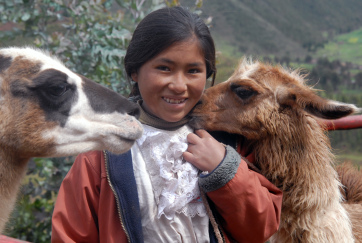Peru: Introduction
 |
 |
Report prepared by Allison Hebert and Gabrielle Osswald, students in BCIT's Fish, Wildlife and Recreation Program.
Geography
Peru is in South America. It borders Ecuador and Columbia to the north, Chile in the south, Brazil and Bolivia to the east, and the Pacific Ocean to the west. The total area is 1,285,220 km2 (land = 1,280,000 km2 and water = 5,220 km2). It could fit into Canada almost eight times (7.76).
Patacancha Valley
Peru is a country of extremes; its elevation ranges from sea level to 6,768 m at Nevado Huascaran (Mount Everest is 8,850 m).
Natural resources include copper, silver, gold, petroleum, timber, fish, iron ore, coal, phosphate, potash, hydropower, and natural gas.
People
The population of Peru is 28,302,603 - 22 people per km2. Canada's population is slightly higher with 33,098,932 - but has only 3.3 people per km2.In Peru, the main spoken languages are:
- Spanish (official)
- Quechua (official)
- Aymara, and a large number of minor Amazonian languages
Economy
Peru's economy reflects its varied geography - abundant mineral resources in the mountains, and excellent fishing grounds in the coastal waters drive the economy. Peru relies heavily on the export of raw materials, and its overdependence on minerals and metals makes it vulnerable to fluctuations in the world market. Also, foreign trade and investment may be deterred by Peru's lack of infrastructure. Overall, unemployment and poverty have stayed persistently high. In recent times, growth has been driven by the Camisea natural gas megaproject, and by exports of minerals, textiles, and agricultural products.
Canadian Exports to Peru
- Machinery ($44.2 M)
- Mineral fuels, oils ($18.8 M)
- Vegetables ($15.5 M)
- Electrical machinery ($15.1 M)
- Cereals ($88.1 M)
Canadian Imports from Peru
- Ores, slag, ash ($177.9 M)
- Copper and copper products ($118.1 M)
- Vegetables ($27.6 M)
- Food waste, animal feed ($25.5 M)
- Precious stones and metals ($895.3 M)


 Funded by TEK
Funded by TEK